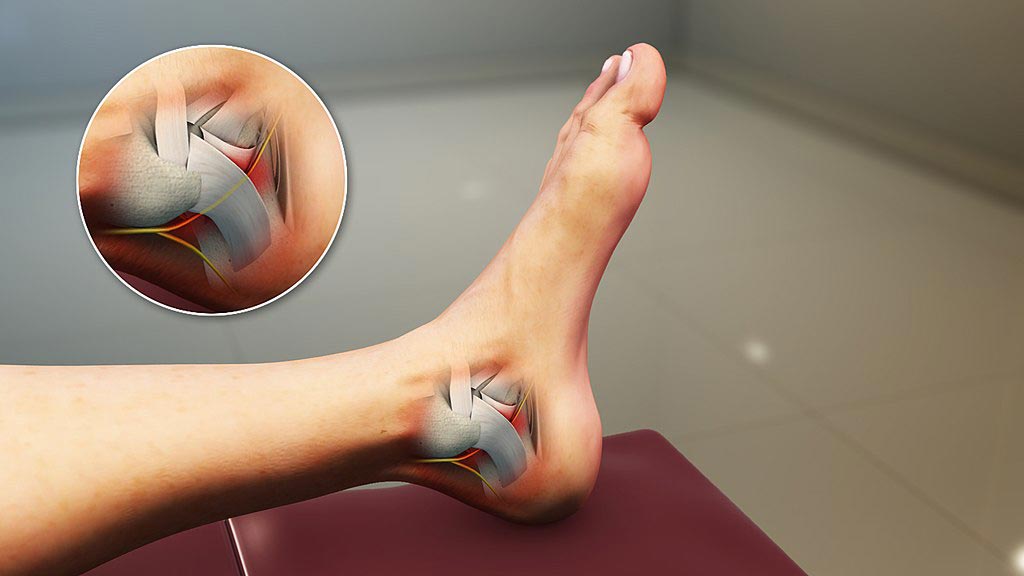- Home
- Tarsal Tunnel Syndrome
Tarsal Tunnel Syndrome
Tarsal Tunnel Syndrome
Tarsal tunnel syndrome is a condition caused by repeated pressure that results in damage on the posterior tibial nerve. Your tibial nerve branches off of the sciatic nerve and is found near your ankle.
The tibial nerve runs through the tarsal tunnel, which is a narrow passageway inside your ankle that is bound by bone and soft tissue. Damage of the tibial nerve typically occurs when the nerve is compressed as a result of consistent pressure.

What are the symptoms of
tarsal tunnel syndrome?
People with tarsal tunnel syndrome may experience pain, numbness, or tingling. This pain can be felt anywhere along the tibial nerve, but it’s also common to feel pain in the sole of the foot or inside the ankle. This can feel like:
- sharp, shooting pains
- pins and needles
- an electric shock
- a burning sensation
Symptoms vary greatly depending on each individual. Some people experience symptoms that progress gradually, and some experience symptoms that begin very suddenly.
Pain and other symptoms are often aggravated by physical activity. But if the condition is long-standing, some people even experience pain or tingling at night or when resting.
BOOK AN APPOINTMENT
You Don't Have To Live With Pain
Dr. Rahul Bade is a specialist Knee & Shoulder Surgeon.
What causes tarsal tunnel syndrome?
Tarsal tunnel syndrome results from compression of the tibial nerve, and it’s often caused by other conditions.
Causes can include:
- severely flat feet, because flattened feet can stretch the tibial nerve
- benign bony growths in the tarsal tunnel
- varicose veins in the membrane surrounding the tibial nerve, which cause compression on the nerve
- inflammation from arthritis
- lesions and masses like tumors or lipomas near the tibial nerve
- injuries or trauma, like an ankle sprain or fracture — inflammation and swelling from which lead to tarsal tunnel syndrome
- diabetes, which makes the nerve more vulnerable to compression
How is tarsal tunnel syndrome treated?
Treating tarsal tunnel syndrome depends on your symptoms and the underlying cause of your pain.
At-home treatments
You can take anti-inflammatory medications (including nonsteroidal anti-inflammatory drugs) to reduce inflammation, which may alleviate compression of the nerve. Resting, icing, compression, and elevation, known as the RICE treatment, may also help reduce swelling and inflammation.
Doctor-prescribed treatments
Steroid injections may also be applied to the affected area to reduce swelling. In some cases, braces and splits may be used to immobilize the foot and limit movement that could compress the nerve. If you have naturally flat feet, you may want to have custom shoes made that support the arches of your feet.
Surgery
In severe, long-term cases, your doctor may recommend a surgery called the tarsal tunnel release. During this procedure, your surgeon will make an incision from behind your ankle down to the arch of your foot. They will release the ligament, relieving the nerve.
A minimally invasive surgery is also used by some surgeons, in which much smaller incisions are made inside your ankle. The surgeon uses tiny instruments to stretch out the ligament. Because there’s less trauma sustained by the tissues, the risk of complications and recovery time are both reduced.
Tarsal tunnel syndrome can be managed or cured with a wide variety of treatment options, but regardless of what the underlying condition is, it’s essential to get early treatment to prevent permanent nerve damage.



